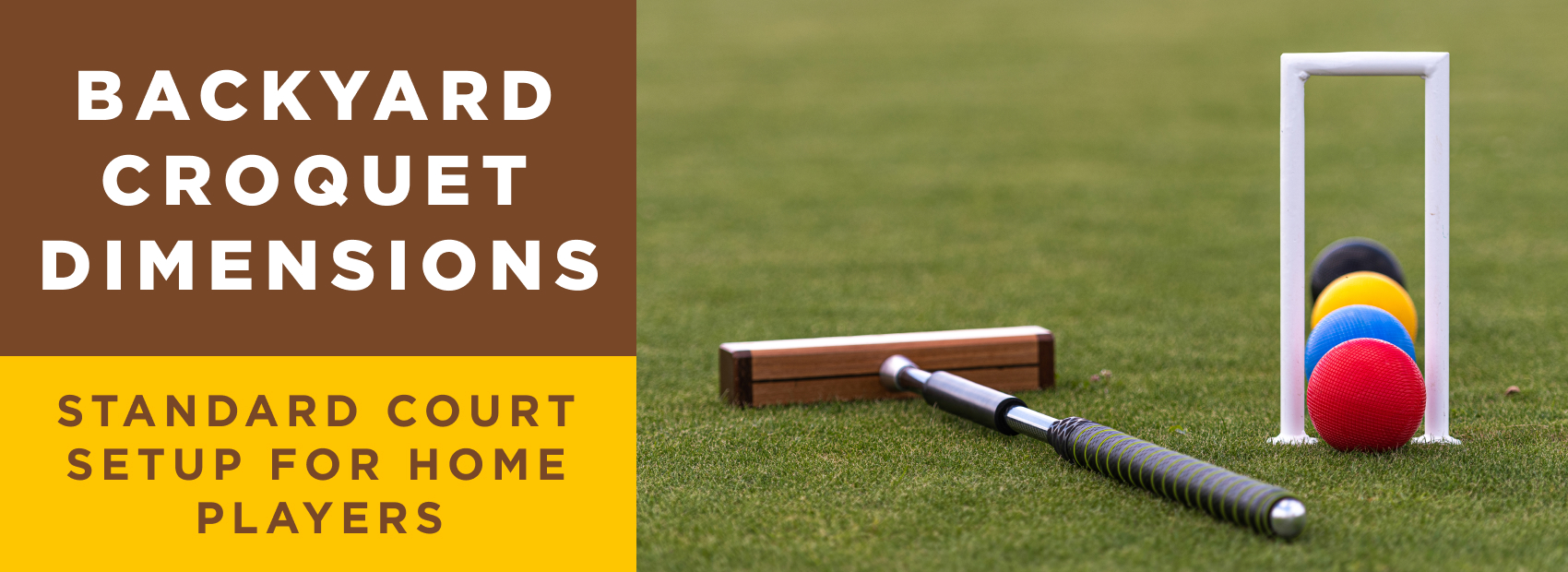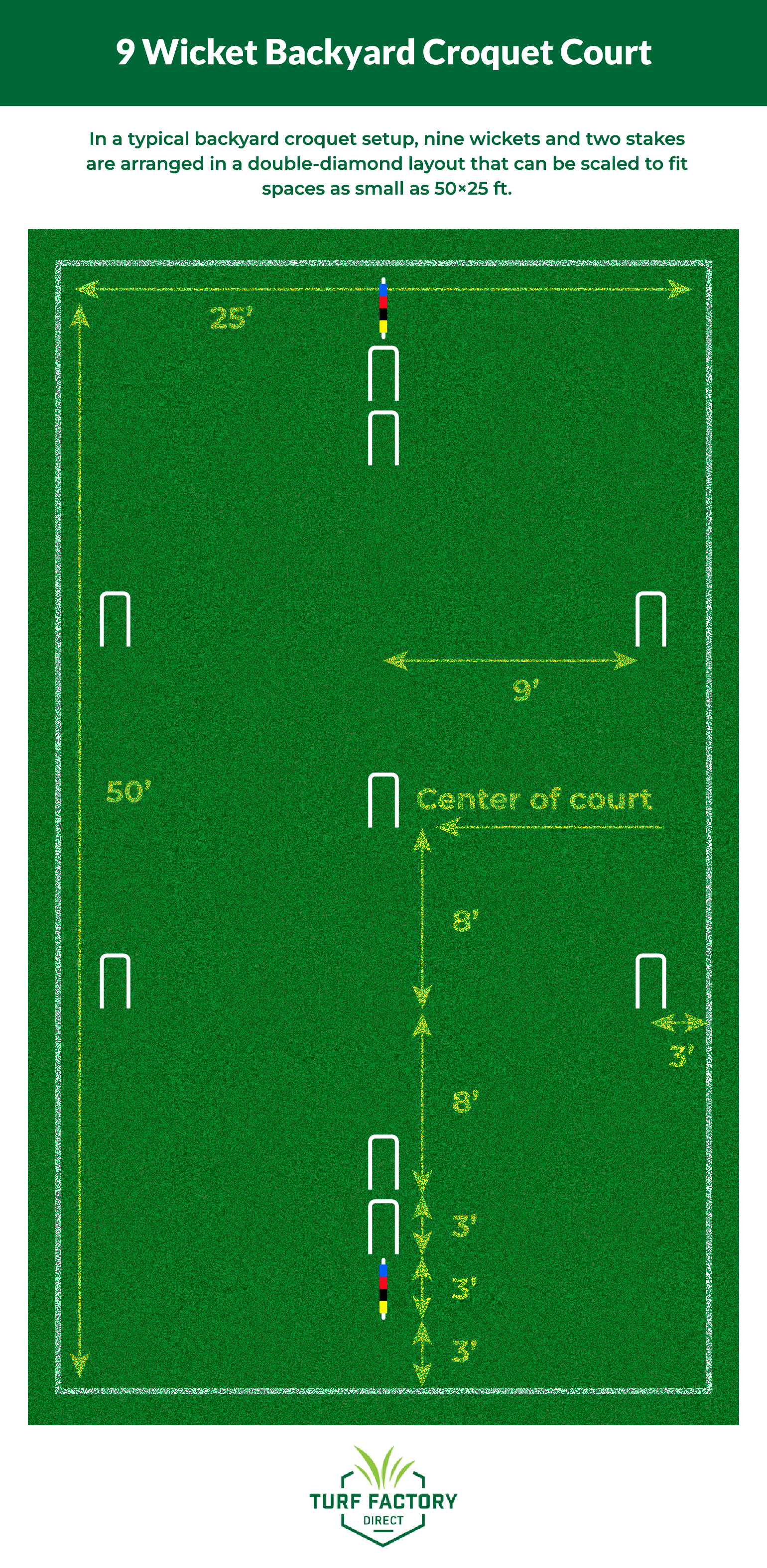
Imagine a radiant afternoon where the clack of mallets meets the gentle roll of croquet balls, and every swing sparks joy, nostalgia, and a sense of friendly rivalry—backyard croquet transforms any outdoor space into an arena of cherished memories and spirited competition.
Typical backyard croquet court standard measurements are 50 feet long by 25 feet wide as most backyards are not the correct size to use official 5:4 ratio dimensions. Setup requires minimal equipment, making it an easy go-to for spontaneous fun.
Key Takeaways
- Standard backyard croquet dimensions measure 50 feet by 25 feet but can be adjusted to fit available space.
- A smooth, level lawn with short grass, or a well-installed backyard croquet artificial turf, provides the best playing conditions.
- The game’s easy setup and flexible rules make it ideal for family entertainment.
Standard Backyard Croquet Court Dimensions
A regulation croquet court is 35 yards by 28 (105 feet by 84 feet), requiring extensive level ground. Most backyard players, however, can create an enjoyable experience with adjusted backyard croquet dimensions for home use.
Official Croquet Court Dimensions
If you wish to preserve the standard proportions of an official six-wicket croquet court, use a ratio of 5:4 (e.g., 75 feet by 60 feet or 50 by 40). These scaled-down dimensions work well for backyard play while maintaining proper gameplay flow. Standard layout elements include:
- Boundary Stakes: Place these 6 feet from each corner.
- Wicket Spacing: Adjust proportionally from the regulation 12-foot spacing.
- Center Wickets: Position them at 1/3 and 2/3 of the court length.
Ideal Backyard Croquet Dimensions
A beginner-friendly court size of 50 feet by 25 feet offers a superb balance between playability and ease of maintenance for a nine-wicket croquet setup. This compact arrangement minimizes the need for extensive mowing or leveling, making it ideal for family games and small gatherings. A slightly smaller setup of 40 feet by 20 feet can also work well for households with very young players. By slightly reducing the wicket spacing and using lightweight mallets, players of all ages can join in and enjoy the game comfortably.
Layout and Setup of a Backyard Croquet Court
A well-planned setup using accurate backyard croquet court standard measurements enhances gameplay, ensuring fair and enjoyable competition.
Creating a Smooth Playing Surface
Achieving a smooth playing surface is crucial for an even ball roll. Start by mowing your lawn to a height of 1/2 to 3/4 inch, ensuring the grass is short and uniform. Remove any debris—rocks, twigs, or leaves—that might interrupt the ball’s path. If you encounter uneven patches, fill them with topsoil and allow time for grass to grow, or consider leveling the area with premium backyard croquet artificial turf from Turf Factory Direct.
Turf Factory Direct offers high-quality turf products that can transform your backyard into a pristine croquet field, ensuring optimal performance and durability.
Hoop and Wicket Placement
Begin by positioning the first stake 3 feet from the boundary at one end, with the second stake placed 3 feet from the opposite end, centered along the court’s midline. Use proportional backyard croquet dimensions when placing hoops. Arrange the nine hoops in the following double-diamond (figure-eight) formation:
- Near Stakes: From each stake, measure 3 feet into the court and place two hoops 3 feet apart along the centerline.
- Center Hoop: Position one hoop exactly in the center of the court.
- Diamond Hoops: Arrange the remaining four hoops in two adjoining diamonds—two on each side of the center hoop—to complete the figure-eight pattern.
All hoops should be set at a 90-degree angle and firmly in the ground. Each hoop must be approximately 4 inches wide—just enough for a croquet ball to pass cleanly. Test each hoop with a ball to ensure proper clearance and alignment.
Six-Wicket vs. Nine-Wicket Croquet
In croquet, the formal version—association croquet—is played on a meticulously maintained rectangular court with six wickets, while the informal style—backyard croquet—is designed for flexible play on a variety of lawn conditions using a nine-wicket setup.
Court Layout and Dimensions
- Competitive Format:
This version uses a precisely proportioned court (following a 5:4 ratio) with six wickets arranged in a layout that encourages long breaks and advanced strategic play. The defined dimensions and careful setup are critical for tournament-level matches. - Casual Format:
Here, the court is typically adapted to available space, such as a backyard or public park, featuring a double-diamond or ladder-like arrangement with nine wickets. The layout can be adjusted to suit various lawn sizes and conditions, making it ideal for recreational play.
Equipment and Playing Surface
- Competitive Format:
The game is played with heavier balls and long, well-balanced mallets on short, uniform grass. This standardization supports accurate and dynamic shot-making, from roquets to precise croquet strokes. - Casual Format:
Equipment for the informal game is usually lighter and more cost-effective, allowing for enjoyable play even on lawns that might not be as perfectly maintained. The equipment is forgiving enough to accommodate the natural variations of typical home play areas.
Rules and Gameplay
- Competitive Format:
The rules are rigorously applied to ensure that every shot counts. Players work to string together multiple scoring opportunities, utilizing bonus strokes for roquets and meticulously following a fixed rotation of play that rewards both precision and tactical planning. - Casual Format:
In the relaxed game, while the basic principles of running wickets remain, rules are often simplified or adjusted on the fly. This flexibility helps all players—regardless of skill level—enjoy a spirited and inclusive game without the pressure of strict regulation.
Enhancing the Backyard Croquet Experience
Thoughtful planning and minor adjustments can elevate the game, making it more enjoyable for all players.
Adapting to Limited Space
When your yard can’t accommodate a full-sized court, scale down the dimensions while preserving the critical gameplay elements. A scaled court of 50–40 feet works well in smaller spaces. Use temporary markers like string or chalk to define boundaries without permanently changing your lawn. To further enhance the game in confined areas, consider the following:
- Equipment Adjustments: Opt for lighter mallets (around 24-28 oz) for improved control and narrower wickets (2-3 inches wide).
- Creative Obstacles: Add a mini croquet course using household items—such as a flower pot or a small wooden ramp—to introduce unique challenges and keep the game exciting.
Adding Fun and Competition
Engage your players by incorporating innovative scoring systems and playful variations:
- Scoreboards: Set up a quirky scoreboard using a whiteboard or chalkboard, complete with creative team names like “The Wicket Warriors” versus “The Mallet Masters.”
- Game Variations: Experiment with timed rounds, progressive scoring, or team formats to keep the matches fresh and exciting.
- Themed Events: Organize themed croquet nights where players dress in vintage attire or fun costumes, adding a festive and memorable twist to your gatherings.
- Quality Equipment: Invest in durable croquet sets with high-quality wooden mallets and sturdy carry bags to ease setup and storage.
Common Mistakes to Avoid
Even a fun backyard game like croquet can face hiccups if certain common mistakes aren’t addressed:
- Uneven Playing Surface: Failing to level your lawn or maintain a consistent grass height can lead to unpredictable ball rolls. Regularly inspect your court and address any patches of uneven ground.
- Improper Hoop Placement: Misaligned or unevenly spaced hoops can disrupt gameplay. Always measure carefully and test the setup with a ball to ensure proper clearance.
- Overcomplicating the Layout: Trying to replicate an official court’s dimensions without adjustments in smaller yards can make the game frustrating. Simplify the layout while keeping the essential ratios intact.
- Neglecting Buffer Zones: Not leaving enough space around the court restricts player movement and increases the risk of accidents. Maintain at least a 5-foot buffer around the play area.
- Ignoring Equipment Quality: Using flimsy mallets or worn-out balls hampers performance and may lead to injury. Invest in quality equipment to enhance both safety and the overall experience.
Encouraging Family and Community Play
Croquet is an easy way to bring people together for lighthearted competition and outdoor activity. Its simple rules and accessible format make it an excellent social game. Designating a dedicated croquet area in your backyard creates a warm, inviting space that naturally encourages social interaction and spontaneous play. Here are some of the key benefits:
- Outdoor Activity: Playing croquet gets you outdoors, where natural sunlight boosts vitamin D levels, improves mood, and enhances overall well-being. Research shows that even a few minutes of outdoor exercise can significantly elevate self-esteem and reduce stress.
- Physical Exercise: Although it’s a low-impact sport, croquet involves walking, bending, and swinging—a combination that offers gentle physical exercise ideal for all ages.
- Mental Stimulation: Croquet challenges your mind by requiring precision, strategy, and quick problem-solving. This cognitive engagement helps keep your brain active, much like puzzles or chess.
- Family Bonding: The game’s inclusive nature makes it perfect for family gatherings, allowing parents, grandparents, and children to connect over friendly competition.
- Community Building: Organize regular croquet events or tournaments to foster neighborhood camaraderie. Inviting friends and neighbors to play creates lasting social bonds and a sense of belonging.
Enhancing Your Croquet Lawn
A smooth lawn is the foundation of a great croquet experience. Turf Factory Direct offers the best backyard croquet artificial turf that ensures your playing surface is consistently level and durable. Designed to handle regular foot traffic and outdoor conditions, our high-quality turf guarantees smooth ball roll and low maintenance.
When setting up your court, be sure to factor in proper backyard croquet dimensions to maximize playability and comfort. Consider incorporating expert turf recommendations to create a resilient, lush playing field that enhances gameplay and adds beauty to your backyard.
Experience the superior quality and durability of premium backyard croquet artificial turf from Turf Factory Direct. Request a quote today.








